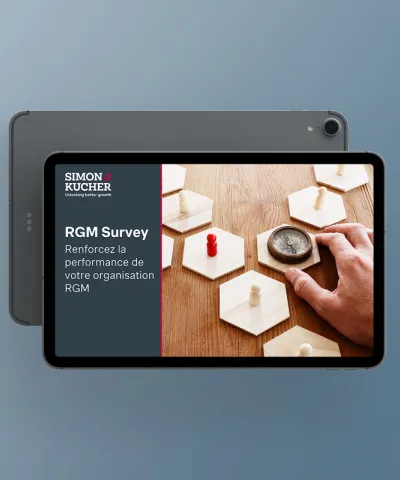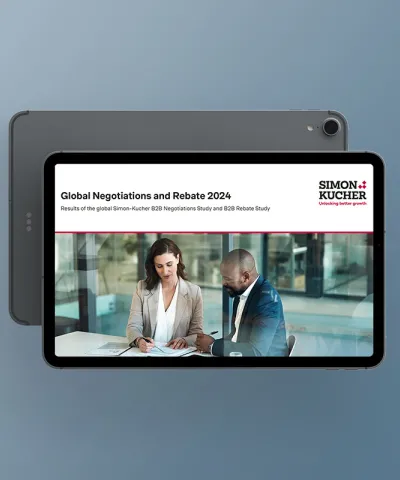After much controversy and debate, everyone has generally agreed that when tariffs rise, so do prices. That puts sales leaders, who have enough to deal with already, on the hot(ter) seat. Higher costs of raw materials either compress gross margins or get passed to customers. Depending on elasticity, passing price increases on to customers negatively impacts volume demand. Salespeople generally don’t enjoy having that conversation. Their default might be to push for volume at the expense of price, but in today’s environment that’s a dangerous path. Instead, sales leaders need to guide their teams with precision, discipline, and data-driven strategy to continue growing both revenue and profit.
At Simon-Kucher, we’ve spent decades helping organizations drive growth in spite of economic headwinds. Our research consistently shows that top-performing companies don’t merely react to pricing pressure, they embrace it as an opportunity to optimize their commercial strategy. Here are five critical actions sales leaders can take to ensure continued growth despite tariff-driven challenges:
1. Anchor the sales team in value, not price
Now more than ever, your customers need to understand what they’re getting for their money. Sales teams must lead with value: quality, superior service, speed of delivery, reliability, innovation, and business outcomes. This isn’t a time to default to discounting, it’s a time to sharpen the value story. One element of that value story could be how well you help your customers optimize their upstream supply chain.
Simon-Kucher research shows that companies with a strong value communication framework are twice as likely to maintain pricing power during inflationary periods. Most of our clients state that fewer than 25% of their sales forces can effectively articulate the value of their solutions. Train your team to clearly articulate how your solution solves the customer’s biggest problems and why it remains a smart investment even at a higher price point.
2. Segment and prioritize sales accounts strategically
Not all customers respond the same way to tariff-driven price increases. Some are highly price-sensitive, others are more resilient. It is especially important now to re-segment your customers based on margin potential, strategic value, and willingness to pay.
Equip your sales teams with tools to differentiate offers and conversations accordingly. High-margin, high-loyalty customers might accept price increases with the right messaging, while volume-driven accounts may require creative bundling or incentive-based models. Don’t treat everyone the same.
3. Give the frontline confidence with data and guardrails
When prices increase, sales reps can feel like they’re walking a tightrope… unsure how far they can push before losing the deal. This is where a graduated spectrum meets a binary outcome. This can lead to over-discounting and margin erosion. That’s why we advocate for pricing guardrails and deal scoring tools that give your team confidence and clarity.
Sales leaders should partner closely with Pricing and Finance to ensure reps have access to real-time insights: win/loss data, deal benchmarks, and profitability metrics. Our studies reveal that organizations using deal scoring frameworks see 5-10% improvement in average deal margins. For everyone out there win underutilized CRM systems and weak data, this is an obvious pre-requisite. For those with strong monthly funnel reviews, this is why you have been building that muscle for years.
4. Rethink sales incentives to reward profit, not just revenue
Compensation plans drive behavior. If your salespeople are still rewarded solely on revenue, they’ll naturally chase volume, even if it hurts the bottom line. Tariffs will exacerbate this dynamic. This is the burning platform business case to evolve incentive structures to include margin-based metrics.
Aligning incentives with profitability not only protects your business but encourages smarter selling. Reward reps who maintain price discipline, up-sell value-added services, or convert customers to more profitable solutions. This creates a virtuous cycle of healthy growth. One caution, measure twice and cut once to make sure change management helps all sales reps through this transition.
5. Empower sales leaders at every level to coach for commercial excellence
Tariffs aren’t just a pricing problem, they’re a leadership challenge. Frontline managers must become coaches who can reinforce pricing discipline, guide opportunity qualification, and debrief on lost deals with a commercial lens. Sales talent requirements are changing, and you may need HR’s help in recruiting, screening, and developing sales professionals with new competencies.
At Simon-Kucher, we’ve seen tremendous impact when sales leaders use structured coaching frameworks focused on commercial excellence. One client improved net revenue retention by 12 points in under a year simply by upskilling their (largely forgotten) mid-level sales managers.
Final thoughts: smarter sales start with strategy
Tariffs may be beyond our control, but how we respond is not. Sales leaders who stay focused on value, equip their teams with the right tools, and embrace a disciplined, insight-driven approach will come out stronger. Growth is still possible, but only for those who are willing to lead differently. In times of change, the best companies don’t just survive, they transform.
Whether you're adjusting your sales model, rethinking incentives, or empowering frontline teams, we’re here to help. Let’s talk about how your sales team can grow smarter, despite tariffs.
Contact us today.








